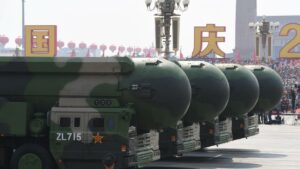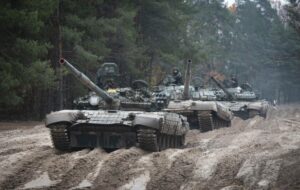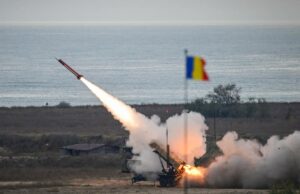NASHVILLE, Tenn. — The prospect of conflict with China or Russia, two global powers that have long invested in military science and technology, is motivating the U.S. to push the digital envelope.
To face this challenge, the U.S. Department of Defense is focused on artificial intelligence, cybersecurity and other increasingly software-centric capabilities. And the tides of information generated by everyday, bureaucratic practices and countless military sensors in the field are proving to be the lifeblood.
In fact, Army officials in November, on the heels of Project Convergence, a massive Joint All-Domain Command and Control experiment, said they are dealing with too much data, and that it needs wrangling quickly.
C4ISRNET on Dec. 8 spoke to Jennifer Swanson, the deputy assistant secretary of the Army for data, engineering and software, a role closely tied to the service’s digital transformation. Portions of this interview, conducted on the sidelines of Technical Exchange Meeting 9 in Tennessee, were edited for length and clarity.
How has the U.S. Army’s emerging tech and digital transformation strategy, unveiled at this year’s Association of the U.S. Army conference, been received? What sort of feedback have you heard since October?
Overall, it was received very well, because I think industry sees it as a way to kind of open up the aperture, and everybody is able to play a little bit more effectively than they could before.
At the foundation of that strategy is standards and things that we can provide out to industry that enable their black boxes to plug in. And so it gets rid of a lot of the — ultimately all of the — vendor lock issues that we may have in parts of the architecture today. So, I think we’ve gotten a lot of really positive feedback from industry.
We put out our unified data reference architecture, version one, as a request for information to industry at the end of October. It closed on Dec. 2. We got 31 responses, which I was really happy with.
Certainly, the data players that I’ve recognized in this space for a long time were respondents, as well as a bunch of other companies. We’re still assessing all of the responses, but overall it’s very positive. Everybody thinks we seem to be on the right track with data mesh, and, like I said, it opens up the space.
What are some of the metrics you or the Army, more broadly, are using to measure success when it comes to data processing or something like a data mesh?
It’s so new right now that I would tell you our metrics, at this moment, are a little bit more subjective, because we haven’t implemented yet.
Right now, I think that the RFI responses are a metric. Are we on the right track or not? Does industry think this makes sense? And that’s really what we want from them. Does this make sense? Can you plug into this? Can you play, or did we miss? Do we have a huge gap that we need to close?
Another metric that I’m pretty excited about — and, again, it’s not like a measurement, but it’s definitely a thing — is we have been able to not just for ASA(ALT) make this a thing, but for the Army make this a thing, in a very short period of time.
The chief data officer, Dr. David Markowitz, is completely on board with the data-mesh concept, and the Army data plan is adjusting so that we have a data mesh, and not these disparate data fabrics, which is where it started.
RELATED

We’ve only been a thing for six months, so I’m pretty happy with where we’re at. I think that the Army acceptance of it is significant.
Now, once we start implementing the data mesh, then we’re going to be looking at metrics like data products, which is a key component of data mesh, and the utility of those data products. How many data products does a domain have? What is the consumption of those data products? Because I think it’s going to help us to adjust. Somebody might think a data product is needed, but if nobody’s consuming it, then it’s not needed. So just making sure that we keep the battlefield cleaned up, from that standpoint, will be certainly one of the key metrics.
And then, of course, we’re going to be looking at bandwidth usage and how are we doing with this versus how we’re doing with the traditional way of managing data. The network’s critical to everything we do.
Do you think the Army is doing enough — and moving quickly enough — to achieve Secretary Christine Wormuth’s priority of data centricity and fluency?
In six months, I just told you all the stuff we did. I feel pretty good about it.
I think that there was a period of time where people were trying to wrap their head around: ‘What does it mean? What is data centricity in the context of what the Army does and how we do what we do?’ I think it took the Army a little bit of time to try to figure that out.
Now that we know, we understand what it needs to look like, I think we’re moving very fast in that direction.
RELATED

Our intent, by the end of this fiscal year, is to have this unified data reference architecture completed and included as a requirement for programs that are going out on the street, meaning you have to plug into this, industry, so tell us how you’re going to do that as part of your proposal. Also, we’ll be looking at how we pivot programs that are already out there to leverage the data mesh.
What is your definition of a data mesh? Or, how do you look at data centricity? How would you explain it to someone who might not be an expert, but is curious?
Data centricity, to me, No. 1, means we have the data that we need to make the decisions that we need to make. And it really, to me, all starts with: What problem are you trying to solve and getting you the data that you need, no matter where you are, getting you access to the right data to make that kind of decision.
It is not data, data data. I don’t know if you heard Alex Miller’s talk yesterday, but he’s 100% right. We can generate absolute tons of data, right? He said something like, ‘I can put more dots on a screen than anybody,’ which is true, but to what end? So what?
So I think data centricity is really about being able to equip users with the data that they need to be able to make the decisions that they need to make, and do the things that they need to do, at a very high level.
Data mesh is really based on data products. It’s not a bunch of dots. But it is the product that you need to do whatever it is that you need to do, and having access to do that.
Colin Demarest is a reporter at C4ISRNET, where he covers military networks, cyber and IT. Colin previously covered the Department of Energy and its National Nuclear Security Administration — namely Cold War cleanup and nuclear weapons development — for a daily newspaper in South Carolina. Colin is also an award-winning photographer.
- SEO Powered Content & PR Distribution. Get Amplified Today.
- Platoblockchain. Web3 Metaverse Intelligence. Knowledge Amplified. Access Here.
- Source: https://www.defensenews.com/battlefield-tech/it-networks/2022/12/26/qa-armys-jennifer-swanson-talks-data-mesh-and-digital-fluency/
- 1
- 10
- 11
- 70
- a
- Able
- About
- about IT
- Absolute
- acceptance
- access
- Achieve
- administration
- AIR
- alex
- All
- already
- and
- architecture
- Army
- around
- Assistant
- Association
- award-winning
- Bandwidth
- base
- based
- Battlefield
- because
- before
- being
- Bit
- Black
- board
- boxes
- broadly
- Bunch
- bureaucratic
- capabilities
- certainly
- challenge
- chief
- China
- Christine
- clarity
- Close
- closed
- closely
- Colorado
- Companies
- Completed
- completely
- component
- concept
- Conduct
- Conference
- conflict
- context
- control
- Convergence
- could
- course
- covered
- critical
- curious
- cyber
- Cybersecurity
- daily
- data
- data processing
- David
- dealing
- decision
- decisions
- Defense
- definitely
- Department
- department of defense
- deputy
- Development
- DID
- digital
- Digital Transformation
- direction
- disparate
- doing
- domain
- Dont
- effectively
- emerging
- enable
- energy
- Engineering
- enough
- Ether (ETH)
- everyday
- everything
- exchange
- excited
- experiment
- expert
- Explain
- fabrics
- Face
- FAST
- feedback
- field
- Figure
- Fiscal
- focused
- Foundation
- from
- gap
- generate
- generated
- getting
- Global
- going
- good
- happy
- having
- head
- heard
- help
- High
- How
- HTTPS
- huge
- image
- images
- implemented
- implementing
- in
- included
- increasingly
- industry
- information
- intent
- Interview
- invested
- issues
- IT
- Jennifer
- Keep
- Key
- Kind
- Know
- Length
- Level
- little
- Long
- long time
- Look
- look like
- looking
- Lot
- make
- MAKES
- Making
- managing
- many
- massive
- Matter
- meaning
- means
- measure
- meeting
- metric
- Metrics
- might
- Military
- moment
- months
- more
- moving
- namely
- National
- Need
- needs
- networks
- New
- November
- nuclear
- october
- Officer
- ONE
- open
- opens
- Operations
- Other
- overall
- part
- parts
- party
- People
- period
- Pivot
- plan
- plato
- Plato Data Intelligence
- PlatoData
- Play
- players
- positive
- powers
- practices
- pretty
- previously
- priority
- Problem
- processing
- Product
- Products
- Programs
- project
- proposal
- prospect
- provide
- provided
- Push
- put
- quickly
- received
- recognized
- reporter
- request
- requirement
- Rid
- Role
- Russia
- Said
- Science
- Science and Technology
- Screen
- security
- sees
- sense
- sensors
- Short
- significant
- since
- SIX
- Six months
- So
- Software
- SOLVE
- some
- Someone
- something
- South
- South carolina
- Space
- specialists
- standards
- start
- started
- starts
- Still
- Strategy
- street
- success
- support
- Talk
- Talks
- tech
- Technology
- The
- their
- thing
- things
- Thinks
- Tied
- time
- to
- today
- tons
- too
- track
- traditional
- Training
- Transformation
- Transformation Strategy
- true
- u.s.
- U.S. Department of Defense
- Ultimately
- understand
- unveiled
- us
- Usage
- users
- utility
- vendor
- version
- Versus
- war
- Weapons
- What
- What is
- which
- WHO
- will
- would
- wrap
- year
- Your
- zephyrnet












